Yun Wang
AutoSCORE: Enhancing Automated Scoring with Multi-Agent Large Language Models via Structured Component Recognition
Sep 26, 2025


Abstract:Automated scoring plays a crucial role in education by reducing the reliance on human raters, offering scalable and immediate evaluation of student work. While large language models (LLMs) have shown strong potential in this task, their use as end-to-end raters faces challenges such as low accuracy, prompt sensitivity, limited interpretability, and rubric misalignment. These issues hinder the implementation of LLM-based automated scoring in assessment practice. To address the limitations, we propose AutoSCORE, a multi-agent LLM framework enhancing automated scoring via rubric-aligned Structured COmponent REcognition. With two agents, AutoSCORE first extracts rubric-relevant components from student responses and encodes them into a structured representation (i.e., Scoring Rubric Component Extraction Agent), which is then used to assign final scores (i.e., Scoring Agent). This design ensures that model reasoning follows a human-like grading process, enhancing interpretability and robustness. We evaluate AutoSCORE on four benchmark datasets from the ASAP benchmark, using both proprietary and open-source LLMs (GPT-4o, LLaMA-3.1-8B, and LLaMA-3.1-70B). Across diverse tasks and rubrics, AutoSCORE consistently improves scoring accuracy, human-machine agreement (QWK, correlations), and error metrics (MAE, RMSE) compared to single-agent baselines, with particularly strong benefits on complex, multi-dimensional rubrics, and especially large relative gains on smaller LLMs. These results demonstrate that structured component recognition combined with multi-agent design offers a scalable, reliable, and interpretable solution for automated scoring.
Lay2Story: Extending Diffusion Transformers for Layout-Togglable Story Generation
Aug 12, 2025Abstract:Storytelling tasks involving generating consistent subjects have gained significant attention recently. However, existing methods, whether training-free or training-based, continue to face challenges in maintaining subject consistency due to the lack of fine-grained guidance and inter-frame interaction. Additionally, the scarcity of high-quality data in this field makes it difficult to precisely control storytelling tasks, including the subject's position, appearance, clothing, expression, and posture, thereby hindering further advancements. In this paper, we demonstrate that layout conditions, such as the subject's position and detailed attributes, effectively facilitate fine-grained interactions between frames. This not only strengthens the consistency of the generated frame sequence but also allows for precise control over the subject's position, appearance, and other key details. Building on this, we introduce an advanced storytelling task: Layout-Togglable Storytelling, which enables precise subject control by incorporating layout conditions. To address the lack of high-quality datasets with layout annotations for this task, we develop Lay2Story-1M, which contains over 1 million 720p and higher-resolution images, processed from approximately 11,300 hours of cartoon videos. Building on Lay2Story-1M, we create Lay2Story-Bench, a benchmark with 3,000 prompts designed to evaluate the performance of different methods on this task. Furthermore, we propose Lay2Story, a robust framework based on the Diffusion Transformers (DiTs) architecture for Layout-Togglable Storytelling tasks. Through both qualitative and quantitative experiments, we find that our method outperforms the previous state-of-the-art (SOTA) techniques, achieving the best results in terms of consistency, semantic correlation, and aesthetic quality.
Interaction, Process, Infrastructure: A Unified Architecture for Human-Agent Collaboration
Jun 13, 2025Abstract:As AI tools proliferate across domains, from chatbots and copilots to emerging agents, they increasingly support professional knowledge work. Yet despite their growing capabilities, these systems remain fragmented: they assist with isolated tasks but lack the architectural scaffolding for sustained, adaptive collaboration. We propose a layered framework for human-agent systems that integrates three interdependent dimensions: interaction, process, and infrastructure. Crucially, our architecture elevates process to a primary focus by making it explicit, inspectable, and adaptable, enabling humans and agents to align with evolving goals and coordinate over time. This model clarifies limitations of current tools, unifies emerging system design approaches, and reveals new opportunities for researchers and AI system builders. By grounding intelligent behavior in structured collaboration, we reimagine human-agent collaboration not as task-specific augmentation, but as a form of coherent and aligned system for real-world work.
Contrast-Invariant Self-supervised Segmentation for Quantitative Placental MRI
May 30, 2025Abstract:Accurate placental segmentation is essential for quantitative analysis of the placenta. However, this task is particularly challenging in T2*-weighted placental imaging due to: (1) weak and inconsistent boundary contrast across individual echoes; (2) the absence of manual ground truth annotations for all echo times; and (3) motion artifacts across echoes caused by fetal and maternal movement. In this work, we propose a contrast-augmented segmentation framework that leverages complementary information across multi-echo T2*-weighted MRI to learn robust, contrast-invariant representations. Our method integrates: (i) masked autoencoding (MAE) for self-supervised pretraining on unlabeled multi-echo slices; (ii) masked pseudo-labeling (MPL) for unsupervised domain adaptation across echo times; and (iii) global-local collaboration to align fine-grained features with global anatomical context. We further introduce a semantic matching loss to encourage representation consistency across echoes of the same subject. Experiments on a clinical multi-echo placental MRI dataset demonstrate that our approach generalizes effectively across echo times and outperforms both single-echo and naive fusion baselines. To our knowledge, this is the first work to systematically exploit multi-echo T2*-weighted MRI for placental segmentation.
Leveraging large language models and traditional machine learning ensembles for ADHD detection from narrative transcripts
May 27, 2025Abstract:Despite rapid advances in large language models (LLMs), their integration with traditional supervised machine learning (ML) techniques that have proven applicability to medical data remains underexplored. This is particularly true for psychiatric applications, where narrative data often exhibit nuanced linguistic and contextual complexity, and can benefit from the combination of multiple models with differing characteristics. In this study, we introduce an ensemble framework for automatically classifying Attention-Deficit/Hyperactivity Disorder (ADHD) diagnosis (binary) using narrative transcripts. Our approach integrates three complementary models: LLaMA3, an open-source LLM that captures long-range semantic structure; RoBERTa, a pre-trained transformer model fine-tuned on labeled clinical narratives; and a Support Vector Machine (SVM) classifier trained using TF-IDF-based lexical features. These models are aggregated through a majority voting mechanism to enhance predictive robustness. The dataset includes 441 instances, including 352 for training and 89 for validation. Empirical results show that the ensemble outperforms individual models, achieving an F$_1$ score of 0.71 (95\% CI: [0.60-0.80]). Compared to the best-performing individual model (SVM), the ensemble improved recall while maintaining competitive precision. This indicates the strong sensitivity of the ensemble in identifying ADHD-related linguistic cues. These findings demonstrate the promise of hybrid architectures that leverage the semantic richness of LLMs alongside the interpretability and pattern recognition capabilities of traditional supervised ML, offering a new direction for robust and generalizable psychiatric text classification.
Artificial Intelligence Bias on English Language Learners in Automatic Scoring
May 15, 2025Abstract:This study investigated potential scoring biases and disparities toward English Language Learners (ELLs) when using automatic scoring systems for middle school students' written responses to science assessments. We specifically focus on examining how unbalanced training data with ELLs contributes to scoring bias and disparities. We fine-tuned BERT with four datasets: responses from (1) ELLs, (2) non-ELLs, (3) a mixed dataset reflecting the real-world proportion of ELLs and non-ELLs (unbalanced), and (4) a balanced mixed dataset with equal representation of both groups. The study analyzed 21 assessment items: 10 items with about 30,000 ELL responses, five items with about 1,000 ELL responses, and six items with about 200 ELL responses. Scoring accuracy (Acc) was calculated and compared to identify bias using Friedman tests. We measured the Mean Score Gaps (MSGs) between ELLs and non-ELLs and then calculated the differences in MSGs generated through both the human and AI models to identify the scoring disparities. We found that no AI bias and distorted disparities between ELLs and non-ELLs were found when the training dataset was large enough (ELL = 30,000 and ELL = 1,000), but concerns could exist if the sample size is limited (ELL = 200).
SPAST: Arbitrary Style Transfer with Style Priors via Pre-trained Large-scale Model
May 13, 2025Abstract:Given an arbitrary content and style image, arbitrary style transfer aims to render a new stylized image which preserves the content image's structure and possesses the style image's style. Existing arbitrary style transfer methods are based on either small models or pre-trained large-scale models. The small model-based methods fail to generate high-quality stylized images, bringing artifacts and disharmonious patterns. The pre-trained large-scale model-based methods can generate high-quality stylized images but struggle to preserve the content structure and cost long inference time. To this end, we propose a new framework, called SPAST, to generate high-quality stylized images with less inference time. Specifically, we design a novel Local-global Window Size Stylization Module (LGWSSM)tofuse style features into content features. Besides, we introduce a novel style prior loss, which can dig out the style priors from a pre-trained large-scale model into the SPAST and motivate the SPAST to generate high-quality stylized images with short inference time.We conduct abundant experiments to verify that our proposed method can generate high-quality stylized images and less inference time compared with the SOTA arbitrary style transfer methods.
Saliency-driven Dynamic Token Pruning for Large Language Models
Apr 09, 2025

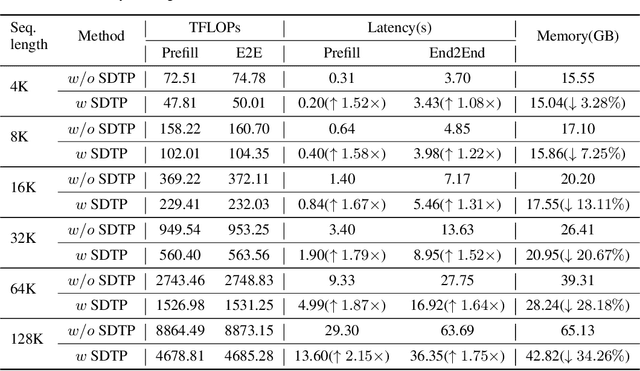
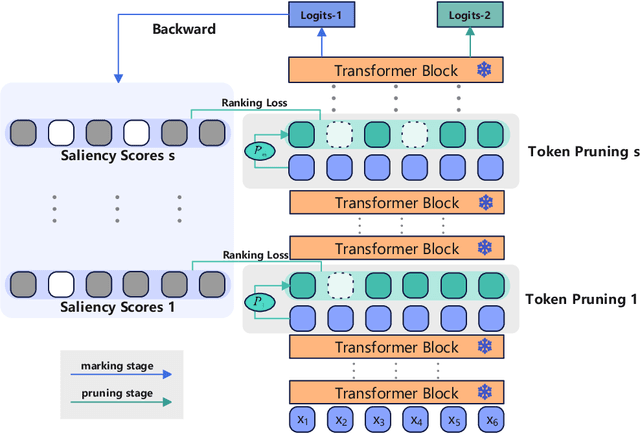
Abstract:Despite the recent success of large language models (LLMs), LLMs are particularly challenging in long-sequence inference scenarios due to the quadratic computational complexity of the attention mechanism. Inspired by the interpretability theory of feature attribution in neural network models, we observe that not all tokens have the same contribution. Based on this observation, we propose a novel token pruning framework, namely Saliency-driven Dynamic Token Pruning (SDTP), to gradually and dynamically prune redundant tokens based on the input context. Specifically, a lightweight saliency-driven prediction module is designed to estimate the importance score of each token with its hidden state, which is added to different layers of the LLM to hierarchically prune redundant tokens. Furthermore, a ranking-based optimization strategy is proposed to minimize the ranking divergence of the saliency score and the predicted importance score. Extensive experiments have shown that our framework is generalizable to various models and datasets. By hierarchically pruning 65\% of the input tokens, our method greatly reduces 33\% $\sim$ 47\% FLOPs and achieves speedup up to 1.75$\times$ during inference, while maintaining comparable performance. We further demonstrate that SDTP can be combined with KV cache compression method for further compression.
FusionSegReID: Advancing Person Re-Identification with Multimodal Retrieval and Precise Segmentation
Mar 27, 2025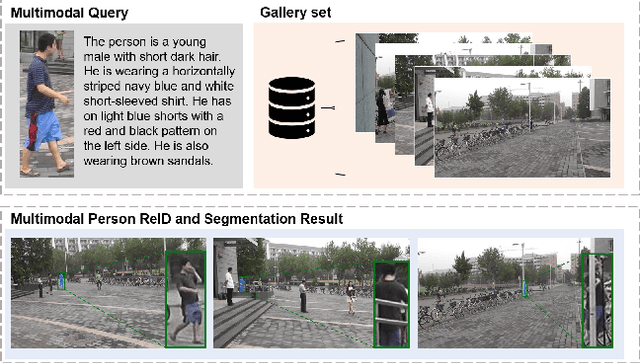
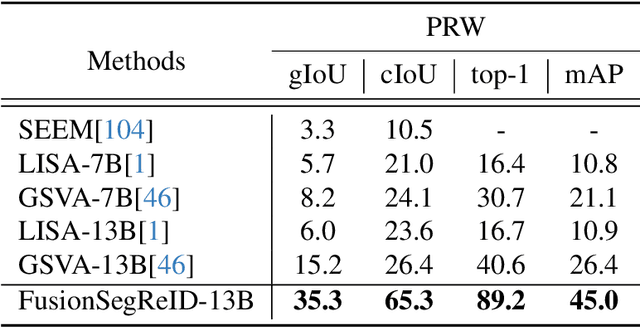
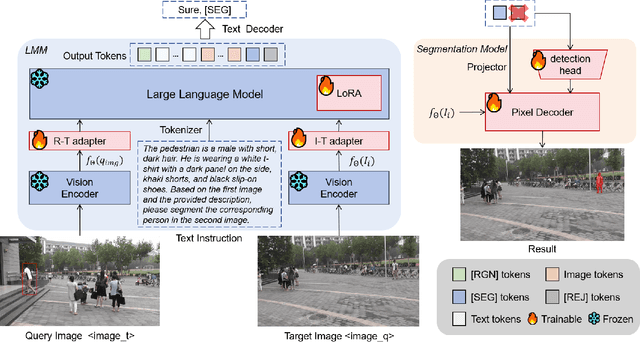
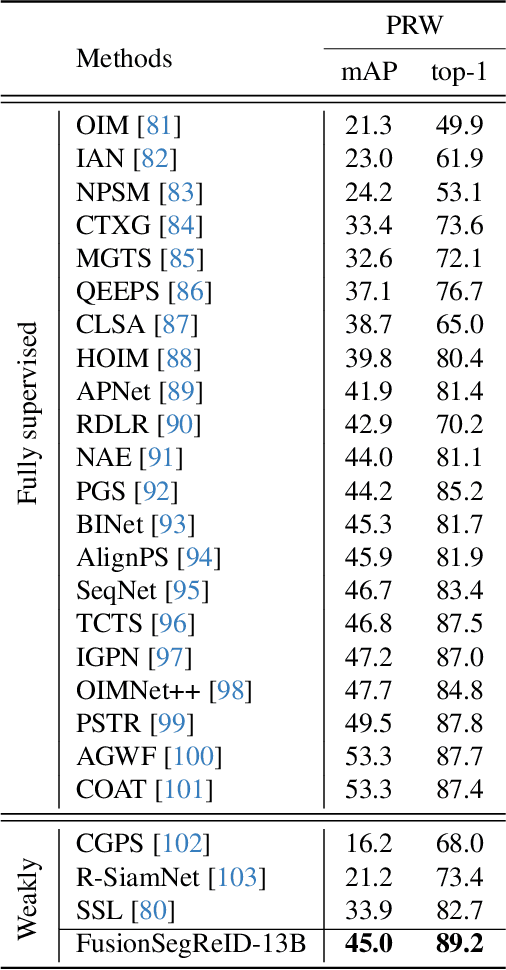
Abstract:Person re-identification (ReID) plays a critical role in applications like security surveillance and criminal investigations by matching individuals across large image galleries captured by non-overlapping cameras. Traditional ReID methods rely on unimodal inputs, typically images, but face limitations due to challenges like occlusions, lighting changes, and pose variations. While advancements in image-based and text-based ReID systems have been made, the integration of both modalities has remained under-explored. This paper presents FusionSegReID, a multimodal model that combines both image and text inputs for enhanced ReID performance. By leveraging the complementary strengths of these modalities, our model improves matching accuracy and robustness, particularly in complex, real-world scenarios where one modality may struggle. Our experiments show significant improvements in Top-1 accuracy and mean Average Precision (mAP) for ReID, as well as better segmentation results in challenging scenarios like occlusion and low-quality images. Ablation studies further confirm that multimodal fusion and segmentation modules contribute to enhanced re-identification and mask accuracy. The results show that FusionSegReID outperforms traditional unimodal models, offering a more robust and flexible solution for real-world person ReID tasks.
DyArtbank: Diverse Artistic Style Transfer via Pre-trained Stable Diffusion and Dynamic Style Prompt Artbank
Mar 11, 2025



Abstract:Artistic style transfer aims to transfer the learned style onto an arbitrary content image. However, most existing style transfer methods can only render consistent artistic stylized images, making it difficult for users to get enough stylized images to enjoy. To solve this issue, we propose a novel artistic style transfer framework called DyArtbank, which can generate diverse and highly realistic artistic stylized images. Specifically, we introduce a Dynamic Style Prompt ArtBank (DSPA), a set of learnable parameters. It can learn and store the style information from the collection of artworks, dynamically guiding pre-trained stable diffusion to generate diverse and highly realistic artistic stylized images. DSPA can also generate random artistic image samples with the learned style information, providing a new idea for data augmentation. Besides, a Key Content Feature Prompt (KCFP) module is proposed to provide sufficient content prompts for pre-trained stable diffusion to preserve the detailed structure of the input content image. Extensive qualitative and quantitative experiments verify the effectiveness of our proposed method. Code is available: https://github.com/Jamie-Cheung/DyArtbank
 Add to Chrome
Add to Chrome Add to Firefox
Add to Firefox Add to Edge
Add to Edge